- This event has passed.
PhD Discussion. Armando Cortés-Reséndiz and Maria J. Ugarte-Orozco
Decoding skeletal muscle-liver axis in the context of sarcopenia: Towards the multi organ on a chip
Armando Cortés-Reséndiz (1),*, Francesco De Chiara (1), Javier Ramón Azcón (1,2)
1 Institute for Bioengineering of Catalonia, Barcelona, Spain
2 ICREA-Institució Catalana de Recerca i Estudis Avançats, Barcelona, Spain
*acortes@ibecbarcelona.eu
Sarcopenia is characterized by marked reductions in skeletal muscle mass and quality, which impacts the mobility and autonomy of patients. [1] They suffer not only from low physical performance and strength but also face a greater risk of falls and further comorbidities, one of those being non-alcoholic steatohepatitis (NASH), as reported by some studies [2]. These have described a correlation between diminished muscle strength and the onset of NASH [2]. Thus, our study examines sarcopenic phenotypes in three-dimensional muscle tissues in contact with conditioned media from NASH.
This approach involves subjecting skeletal muscle tissues to incubation in culture media derived from a pre-established model of NASH. We encapsulated human hepatocytes and hepatic stellate cells (HSC) in a collagen-based hydrogel. After treatment, our model accumulates excess lipids upon a challenge with non-esterified fatty acids (NEFAs), shows activation of HSC, primary drivers of fibrosis, and exhibits a proinflammatory environment. We also show the presence of apoptotic phenotypes and paracrine signaling between cell types of the liver. Such conditions trigger an atrophic phenotype in healthy skeletal muscle tissues, fabricated by encapsulating human myoblasts in a Matrigel and fibrinogen matrix using PDMS casting. Skeletal muscle tissues were functionally evaluated as well by electrical pulse stimulation (EPS). We show that treated tissues exert lower contractile forces during EPS regime compared to our control conditions.
Both of our models pose valuable tools to aid in the identification of potential drug targets and therapeutic strategies, as they mimic key features and cellular microenvironments of sarcopenia and NASH. For this reason, our investigation marks a critical step toward understanding the intricate associations between these diseases. With the multi organ on a chip in sight, we will focus on integrating both models inside an organ-on-chip device.
Plasmonic Biosensors to evaluate complement activation in serum of patients with myasthenia gravis.
Maria J. Ugarte-Orozco 1*, Javier Ramón-Azcón 1, Eduard Gallardo Vigo 2
1 Institute for Bioengineering of Catalonia (IBEC) – Barcelona (Spain)
2 Institut de Recerca Hospital de la Santa Creu i Sant Pau. U.A.B. – Barcelona (Spain)
*mugarte@ibecbarcelona.eu
Myasthenia Gravis (MG), an autoimmune neuromuscular disorder affecting nerve-muscle communication, is characterized by antibodies (Abs) targeting neuromuscular junction (NMJ) receptors. Most patients (80-90%) possess antibodies recognizing the acetylcholine receptor (AChR-MG), these anti-AChR Abs play a crucial role in the complement activation system (e.g., sC5b-9). These Abs lead to the formation of membrane attack complex (MAC) in the NMJ, representing the most critical pathogenic mechanism resulting in AChR depletion and subsequent muscle weakness. [1][2] Complement inhibitor therapies are emerging as effective treatments for anti-AChR Abs; however, the main problem is that considerable variability in treatment response exists, and current clinical tests have difficulty differentiating primary pathogenic mechanisms in each patient. [3] The identification of complement activation biomarkers could facilitate the treatment selection. To address this, we aimed to develop a throughput and scalable plasmonic biointerface as an accurate diagnostic tool, measuring the release of soluble complement (sC5b-9) after its activation by anti-AChR Abs. This biosensor focuses on detecting complement activation in patient samples, confirming the patient’s eligibility for complement inhibitor therapy, such as Eculizumab. This strategy enables label-free detection of AChR autoantibody-mediated complement activation, providing a quick and accurate diagnosis of MG.
In this study, we introduce a biosensor based on a nanostructured polycarbonate substrate from Blu-ray discs with a thin gold layer, utilizing Localized Surface Plasmon Resonance (LSPR) for analysis. It employs antibody-antigen as biorecognition elements to detect sC5b-9 in serum samples. We successfully optimized the biofunctionalization of cys-Protein G, an antibody-binding protein targeting the Fc region that enables orientation to the antibody, exposing the binding sites towards the analyte to enhance surface sensitivity. The biosensing potential was demonstrated by the detection of sC5b-9 in commercial human serum, achieving a limit of detection (LOD) of 0.76 ng/mL in culture media and when working with human sera 0.92 ng/mL. Additionally, the performance of the plasmonic biosensor was assessed with a cohort of sera samples from patients provided by Sant Pau Hospital.
The label-free plasmonic biosensor we developed holds great promise for future applications in POC and portable devices within the realm of precision medicine. By offering detailed insights into the specific pathogenic mechanisms underlying MG in individual patients, our biosensor contributes to more accurate diagnosis and enables the development of personalized treatment strategies. The biosensor’s high sensitivity, scalability, and compatibility with clinical workflows position it as a valuable tool for advancing bioengineering and improving patient care in the field of precision medicine.





